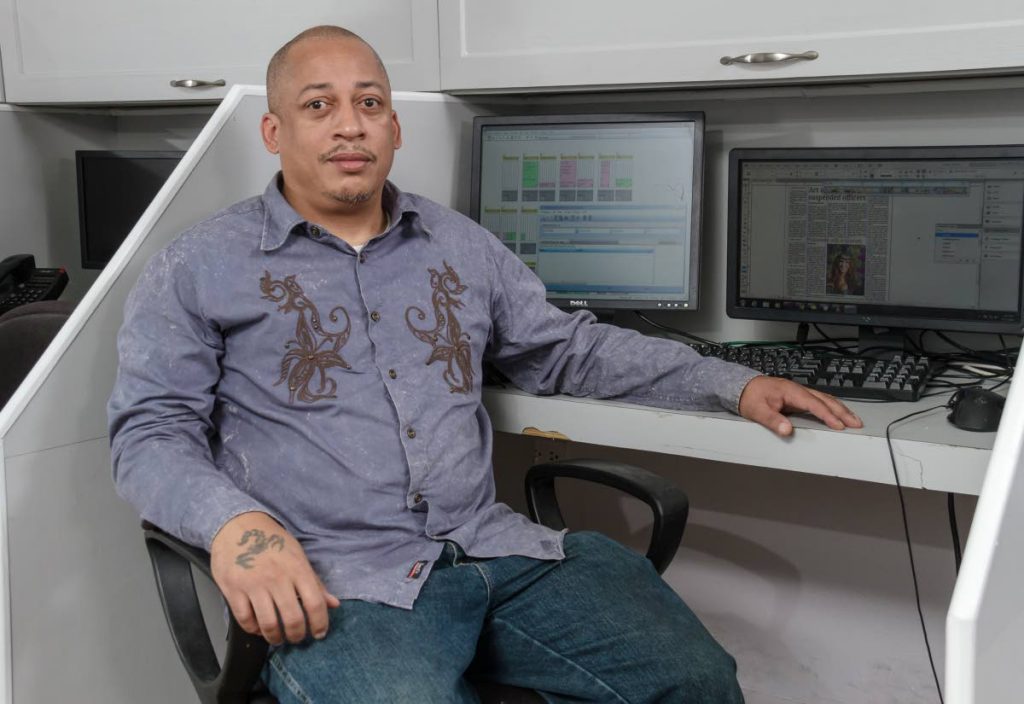Andre Sandy - A life in media

He has seen changes from font type to software. Andre Sandy’s 32 years in media have stretched from paste-up to computers. And he has seen enough to know that the media are on another road of change.
Having spent 25 years at Newsday, he thinks he can foretell the next stage of this Information Age.
“I think everything is going to be more visual. People will stop reading. People will just want to see. Sites like YouTube, Vimeo – people will gravitate to that kind of stuff rather than just reading some copy every day. People like to be read to now. That is why you have audiobooks and those kinds of things,” he said.
Sandy sees the future of newspapers being embedded in a Facebook-like platform. He has seen enough to know.
His first interactions with the media began as a child when his father, the late editor Irwin Sandy, would take him to the Bomb, Blast and Punch newspapers (they were all housed in one building).
His father, he says, “really started me off in the business… I kind of grew up around a press room. So I just ended up working with the Blast newspaper for a good few years after he died.”
He left the Blast “when they were now beginning to use computers… I wanted to expand my horizons a little bit more, so I decided to come to Newsday.”
Fellow paginator Anna Marie Hayban recommended that he join the new paper. At both the Blast and Newsday, Sandy first worked as a paste-up artist, building the pages of columns of type and photos.
He explains that they would “cut the columns of the stories, stick them on a piece of cardboard, and then the lithography room would take a picture of that and make it into a negative for the press.
“If there was one word wrong, we had to go and look around for an old paper with the right word and cut it out and use this single word. We had to try our best to fit it and stick it properly so it was not crooked or anything. Most of the times, you would see the crooked letters,” he adds, laughing.
When computers appeared in newsrooms, Sandy was among the first to use them. The Blast, he thinks, was among the first local media houses to be computerised.
So although he came to Newsday as a paste-up artist, it was easy for him to transition to building pages using a computer.
When Newsday’s original paginators left, two or three years after Sandy started, he and the other paste-up artist, Ringo Maharaj, were incorporated into the pagination department, under the directive of Newsday’s first editor-in-chief, Therese Mills.
Even before Sandy and Maharaj were asked, they would “take turns on the computer just to get some experience. So we built up our experience and we began working in the pagination department.”
Initially, the fast-paced environment of daily news was hard for Sandy to navigate. He was used to doing 32 pages a week, but at Newsday it was now 32 pages a day.
Working in pagination gave Sandy the chance to continue working on his passion; creating digital content. From an early age he was exposed to electronics, a love shared by his father who bought computers for his children.
“I had liked it from since then and I used to do basic programming and make little video games and stuff.”
So the move from paste-up to computers was not scary for Sandy. He likened the transition to the change from VHS (video home system) to CDs.
He had also begun working with 3D software which gave him an easy handle on newspaper software like QuarkXpress and Adobe Pagemaker.
When computers became the norm, pages were sent straight to the pressroom via the Internet. Before that, he remembered, “This guy used to have to jump on the motorcycle and carry all of the negatives up to the pressroom.”
At Newsday, Sandy found family. He remembers many days and weekends spent liming at co-workers’ homes.
While he cannot predict for certain where Newsday will go next, he does not see it selling print newspapers in the next five to ten years. He believes Newsday is going to be doing something different, like television, or delivering news through social media videos and other visual media.
While he knows that change is going to come, the past quarter-century has been a great experience for Sandy. He has met some “nice people” along the way.
But it was meeting Newsday’s grande dame that stands out most for him.
“She was a nice lady,” Sandy said of Therese Mills. “She never made a big deal out of anything really, and never talked down to you. She was very respectful and kind.”


Comments
"Andre Sandy – A life in media"